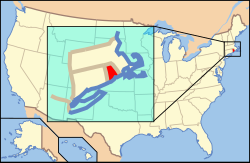| Wine region | |
 | |
| Official name | State of Rhode Island and Providence Plantations |
|---|---|
| Type | U.S. state |
| Year established | 1975[1] |
| Years of wine industry | 1663-present[1] |
| Country | United States |
| Sub-regions | Southeastern New England AVA |
| Climate region | Continental/maritime[2] |
| Total area | 1,215 square miles (777,600 acres)[2] |
| Grapes produced | Cabernet Franc, Chardonnay, Grigio, Landot, Lemberger, Merlot, Pinot Blanc, Pinot Noir, Riesling[1] |
| No. of wineries | 11[2] |
Rhode Island wine refers to wine made from grapes grown in the U.S. state of Rhode Island. Viticulture in Rhode Island began in 1663 when King Charles II of England included wine production among the land uses approved in the royal charter establishing Rhode Island as an English colony. The modern wine industry of Rhode Island began in 1975 when Sakonnet Vineyards was established near Little Compton. Located near the Atlantic Ocean, Rhode Island has one of the most moderate climates of the U.S. northeast.[1]
See also[edit]
References[edit]
- ^ a b c d "Rhode Island: Appellation Profile". Appellation America. 2007. Archived from the original on September 9, 2013. Retrieved November 28, 2007.
- ^ a b c "Rhode Island Wine". Wine Searcher. Retrieved May 8, 2021.

Well, that’s interesting to know that Psilotum nudum are known as whisk ferns. Psilotum nudum is the commoner species of the two. While the P. flaccidum is a rare species and is found in the tropical islands. Both the species are usually epiphytic in habit and grow upon tree ferns. These species may also be terrestrial and grow in humus or in the crevices of the rocks.
View the detailed Guide of Psilotum nudum: Detailed Study Of Psilotum Nudum (Whisk Fern), Classification, Anatomy, Reproduction